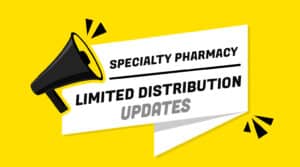The article below should be a learning moment for the specialty pharmacy industry. It is all about going digital…. but it does not get lost in techno babble. It makes the argument that the specialty pharmacy industry is essentially just now emerging from its Paleolithic age…. yep, when the Neanderthals roamed. Heck, it is an industry that still depends heavily on the fax machine!
The article presents examples of other industries that benefitted from embracing digital interoperability through open protocols. If you can’t define ‘digital interoperability’ then you really must read the article. Admittedly, achieving digital interoperability across the healthcare spectrum faces a host of obstacles especially when healthcare providers are reluctant to spend big bucks on the transition and competition among insurers is intense.
The article stops short of stating the obvious….. that the specialty pharmacy industry is at a tipping point. The industry has wrung virtually the last drop of efficiency that is possible without a major breakthrough and digital interoperability seems to be a solution.
—————————————————————————————–
Specialty Pharma’s Next Big Opportunity: It’s Time for Patient Access to Adopt an Open Protocol
In January 2020, the financial conglomerate Visa announced it was acquiring a relatively unknown startup, Plaid, for $5.3 billion. Corporate acquisitions like these are not uncommon, but someone at the United States Department of Justice took notice of this announcement. Visa had established a stranglehold on financial transactions. The Justice Department moved to stop the acquisition on grounds that Plaid posed “a threat to this monopoly: it has been developing an innovative new solution that would be a substitute for Visa’s online debit services.”
Plaid derives its power because of, not in spite of, its invisibility ― a power Visa and ultimately the government could not deny. When a consumer transfers funds electronically from one financial platform to another, or makes a deposit, or applies for a mortgage, there’s a decent chance Plaid is involved. It is the software that powers interoperability among various financial services brokers. It seamlessly patches together transactions that would otherwise be very complicated. Visa, which at the time reportedly held roughly 70 percent of the online debit market, had good reason to feel threatened. Plaid unearthed a way to charge merchants and consumers less for the convenience of online connectivity.
Ultimately, both parties backed out of the acquisition. Visa’s attempted $5.3 billion purchase price looked like a bargain when Plaid was valued at approximately $13.4 billion in a Series D funding round in April 2022.
A similar inflection point now faces the specialty pharmaceutical industry. Along their journey, specialty pharma patients interact with a series of siloed institutions: clinics, specialty pharmacies, copay program vendors, patient assistance programs, nurses, etc. Not unlike the financial industry, these institutions still exchange patient information via fax machines. Facilitating digital interoperability among these various stakeholders is paramount. So what lessons can be gained from the story of Plaid’s meteoric rise?
To diagnose the problem facing specialty pharma, a brief history lesson is in order. The healthcare industry earnestly embarked on its first major digital transformation in the 1990s, when the large-scale transition to electronic recordkeeping began. The industry preference for paper did not disappear overnight. Health systems were slow to digitize their filing cabinets full of charts and other patient data. The Institute of Medicine first advocated a shift from paper-based to electronic medical records in 1992, yet only 13 percent of U.S. healthcare facilities were found to have an EHR system fully implemented by 2004. Many are still making the transition.
Today, specialty drug sales represent more than half of all drug spending. This sector of the healthcare industry has both the incentive ― and the financial wherewithal ― to make the patient experience as seamless as possible. Yet in many ways, it is more backwards than the fintech industry before Plaid. When Plaid effectively forced financial institutions to take an open-protocol approach to digital interoperability, “Every bank (took) their five-year strategy on digitizing and brought it down into one or two years,” CEO Zach Perret said in an interview with Fortune magazine.
In healthcare in general, and specifically in patient services, the transition to an open-protocol approach has been slow and uneven. Open protocol, simply put, is a digital language that facilitates electronic transactions among prescribers, pharmacies, patient support vendors, data aggregators, insurers, and other stakeholders in the specialty pharmaceutical patient journey. Taking “an open protocol approach” means standardizing the open and shared application programming interfaces (APIs) within an industry, or a subsector of a larger industry. Widespread adoption of these protocols allows every stakeholder in the environment to expect a well-defined behavior when interfacing digitally with one another.
The power of the open-protocol approach has been realized across many industries. Look at the example of Twilio. In 2008, the startup launched its first API to make and receive phone calls entirely in the cloud. Now, six years following its IPO, the company is worth billions. Its suite of related tools includes platforms for data security, speech analytics, and customer relations management.
If the healthtech and pharmatech industries can harness this opportunity to standardize their most common digital tasks, integrating record-keeping and transactions among the various parties will be blazing-fast compared to today. This is the essential lesson pharmatech and healtech firms can glean from what Plaid did for the fintech industry.
If an open-protocol approach facilitates convenience, what’s the holdup? As in finance, traditional healthcare stakeholders tend not to share information very efficiently with their competitors. Interoperability has never been an explicit goal of the industry. Yet for specialty pharmaceutical patients, interacting with stakeholders in multiple silos is the norm. Routinely, these patients will need at least one transaction to obtain their prescriptions from the prescriber, then another with the office to provide their HIPAA, TCPA and hub consent, then interact with the hub regarding their coverage, then again with a specialty pharmacy regarding their shipments and out-of-pocket payment, then another to process their copay, another with a patient assistance program, another for adherence support, etc. The patient’s journey is typically long and complicated ― to say nothing of their own recovery from the condition for which they seek treatment.
You may ask: Can an open protocol be HIPAA compliant? HIPAA does not specifically prohibit using and sharing open protocol-based software. Neither does “open protocol” inherently mean “insecure.” Although the industry’s reticence toward sharing back-end software protocols is understandable, nothing is standing in the way of community problem-solving toward ensuring that any private health data transmitted via open protocols remains secure. On the contrary, an open protocol can easily enable such monitoring of the passed data, much better than fax machines and FTP transfers. For now, this reticence is making life more complicated for patients. Their patient journey typically requires engaging with discrete service providers who are often using antiquated means of communication.
The discussion around how to integrate an open-protocol approach into a complicated system governed by HIPAA has been going on for years. Yet many key players in the industry are still on step zero: converting their primary mode of communication from paper to digital.
The time to cross that bridge has passed. As the case study of Plaid makes clear, the time for the industry to embrace open protocol is now.
by Yishai Knobel, CEO and co-founder of RxWare 12/01/2022






